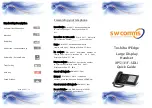
Valid values are:
• Null
• 128 to 149
• 151 to 158
• 161 to 254
Set the
DHCP VLAN Option
value to
Null
to disable the voice VLAN configuration.
Cisco recommends that you use DHCP Option 132.
Step 3
Click
Submit All Changes
.
What to do next
In the
VLAN Settings
section of the
Voice
>
System
tab, you can configure these settings:
• Cisco Discovery Protocol (CDP)
• LLDP-MED
• Network Startup Delay
• VLAN ID
• DHCP VLAN Option
SIP and NAT Configuration
SIP and the Cisco IP Phone
The Cisco IP Phone uses Session Initiation Protocol (SIP), which allows interoperation with all IT service
providers that support SIP. SIP is an IETF-defined signaling protocol that controls voice communication
sessions in an IP network.
SIP handles signaling and session management within a packet telephony network.
Signaling
allows call
information to be carried across network boundaries.
Session management
controls the attributes of an
end-to-end call.
In typical commercial IP telephony deployments, all calls go through a SIP Proxy Server. The receiving phone
is called the SIP user agent server (UAS), while the requesting phone is called the user agent client (UAC).
SIP message routing is dynamic. If a SIP proxy receives a request from a UAS for a connection but cannot
locate the UAC, the proxy forwards the message to another SIP proxy in the network. When the UAC is
located, the response routes back to the UAS, and the two UAs connect using a direct peer-to-peer session.
Voice traffic transmits between UAs over dynamically assigned ports using Real-time Protocol (RTP).
RTP transmits real-time data such as audio and video; RTP does not guarantee real-time delivery of data. RTP
provides mechanisms for the sending and receiving applications to support streaming data. Typically, RTP
runs on top of UDP.
Cisco IP Phone 7800 Series Multiplatform Phones Administration Guide
52
Cisco IP Phone Installation
SIP and NAT Configuration
















































